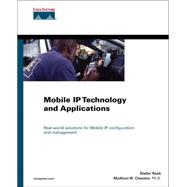Real-world solutions for Cisco IOS® Mobile IP configuration, troubleshooting, and management
- Understand the concept of mobility and the requirements of mobility protocols
- Learn necessary components of a Mobile IP network, including features, functions, and message flows
- Examine security concepts related to Mobile IP, including protocol authentication and dynamic keying
- Evaluate high availability solutions and integration with AAA servers in campus networks
- Explore the features of metro mobility, including reverse tunneling, firewall, NAT traversal, and integration with VPN technologies
- Configure IOS Mobile IP networks, including integration topics such as redundancy, QoS, and VPN
- Manage the Mobile IP infrastructure, including Home Address management, scalability considerations, and network management
- Take a look at the future of Mobile IP, including Layer 2 integration challenges, Mobile IPv6, unstructured mobility, and mobile ad-hoc networking
Two of the world’s most powerful technology trends, the Internet and mobile communications, are redefining how and when people access information. With the majority of information and new services being deployed over IP, the use of devices such as cellular phones, PDAs, and laptops for accessing data networks is pushing the need for “always on” IP connectivity. The evolution of mobile computing points to a coming together of the best of desktop computing and cellular communications—the predictability and "always connected" experience of the desktop combined with the ease of use and mobility of the cell phone.
One challenge to mobile data communication is moving data across different networks. The solution to this problem is a standards-based protocol: Mobile IP. Mobile IP is an open standard that allows users to keep the same IP address, stay connected, and maintain ongoing applications while roaming between IP networks.
Mobile IP Technology and Applications is the first book to address the practical application of Mobile IP in real-world environments. Cisco IOS® Mobile IP configuration, troubleshooting, and management are covered in depth and supported by real-world examples. Mobility solutions addressed in this book include enterprise campus wireless LANs and metropolitan mobility for both individual devices and whole networks. Each example is designed to teach configuration, management, and troubleshooting in a manner that is directly applicable to common mobility needs.
Whether you are looking for an introduction to IP mobility or detailed examples of Mobile IP technology in action, Mobile IP Technology and Applications is your complete resource for reaping the benefits that secure, reliable mobile communications have to offer.
"IP Mobility provides the capability not only for me to connect to the world at large, but for it to find and connect to me."
—Fred Baker, Cisco Fellow, Cisco Systems, Inc.
This book is part of the Cisco Press® Networking Technology Series, which offers networking professionals valuable information for constructing efficient networks, understanding emerging technologies, and building successful networking careers.








